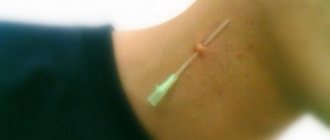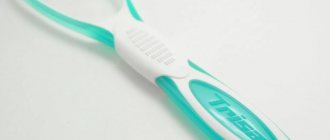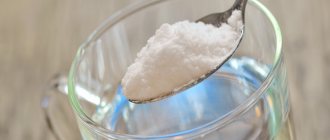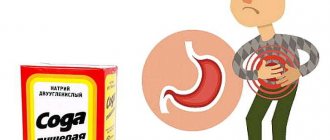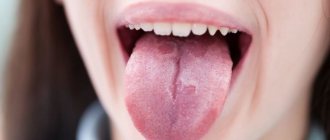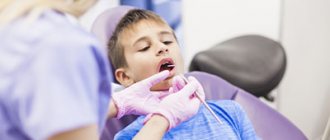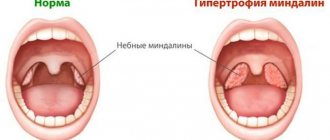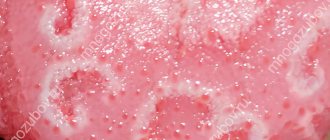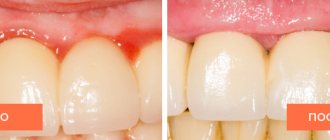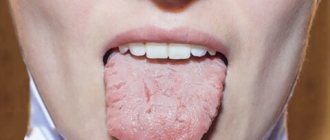White coating on the tongue is a layer of organic substances, bacteria and dead cells, accompanied by swelling of the papillae of the tongue, which can indicate various diseases of the lungs, kidneys or gastrointestinal tract: gastritis, stomach ulcers, enterocolitis.
Plaque on the tongue is a common phenomenon, which many consider simply a feature of their body. And they often forget that you need to brush not only your teeth, but also your tongue. However, many do not know that the appearance of plaque is a symptom usually associated with digestive problems. And it is necessary not only to regularly clean off plaque, but to find the root of the problem and select the appropriate treatment.
If you do not undergo treatment and do not carry out oral care procedures daily, the tongue looks as if it is burned, and bad breath appears. The correct treatment is prescribed by the doctor after testing, and we will try to figure out how to remove plaque from the tongue.
Why do you need to clean your tongue?
When considering the question of how to get rid of white coating on the tongue, you need to start with the basics. The tongue of a healthy person should have a pink color, the surface should be elastic and slightly moisturized. At the same time, a light white coating is not considered a pathology, and this nuisance can be easily eliminated by ordinary cleaning. It's another matter when a strong coating appears. This may indicate the presence of a serious disease in the body.
Cleaning your tongue from plaque at home helps solve the following problems:
- Reduces the concentration of pathogenic bacteria in the oral cavity;
- Prevents the appearance of tartar and caries;
- Freshens breath;
- Improves the functioning of taste buds.
Clinical researches
Clinical studies have proven that regular use of professional toothpaste ASEPTA GENTLE WHITENING for a month allows you to lighten tooth enamel by 1.5 tones, increases anti-caries effectiveness by 3.4 times and increases enamel remineralization by 2.6 times.
Sources:
- Report on determining/confirming the preventive properties of toothpaste “ASEPTA PLUS” GENTLE WHITENING” Author: doctor-researcher A.A. Leontyev, head Department of Preventive Dentistry, Doctor of Medical Sciences, Professor S.B. Ulitovsky First St. Petersburg State Medical University named after. acad. I.P. Pavlova, Department of Preventive Dentistry
- Report on the determination/confirmation of the preventive properties of personal oral hygiene products “ASEPTA PLUS” Remineralization doctor-researcher A.A. Leontyev, head Department of Preventive Dentistry, Doctor of Medical Sciences, Professor S.B. Ulitovsky First St. Petersburg State Medical University named after. acad. I.P. Pavlova, Department of Preventive Dentistry
- Clinical studies of antisensitive toothpaste “Asepta Sensitive” (A.A. Leontyev, O.V. Kalinina, S.B. Ulitovsky) A.A. LEONTIEV, dentist O.V. KALININA, dentist S.B. ULITOVSKY, Doctor of Medical Sciences, Prof. Department of Therapeutic Dentistry, St. Petersburg State Medical University named after. acad. I.P. Pavlova
Reasons for appearance
Why does white plaque appear? The main reason lies in food debris that gets stuck between the lingual papillae. As a result, a favorable environment is created for the proliferation of bacteria. Most of these microorganisms die, but do not disappear without a trace. When in contact with saliva and epithelial particles, they stick to the tongue, forming a plaque. In this case, this plaque is partially removed by salivation. The film usually remains in hard-to-reach places, for example, at the root of the tongue. If it is not cleaned in time, it begins to spread to other areas, gradually covering the entire tongue. Considering that these are the remains of bacteria, the likelihood of developing dental diseases increases sharply.
How is oral candidiasis treated?
To begin with, let's say that treatment is necessary, otherwise the infection spreads to the pharynx, tonsils, and gums. Then the disease descends into the lungs, gastrointestinal tract, liver and causes irreparable harm to them.
When the first signs of candidiasis of the oral mucosa appear, you should contact your dentist or therapist to confirm the diagnosis. When you see your doctor, describe all your symptoms, even those that are not on the list. For example, you have noticed increased anxiety or a tendency to stress lately. Information about the medications you are taking, recent illnesses, and being around sick people is also important. To confirm the diagnosis, it is often enough to take a swab from the oral cavity and carry out the appropriate analysis. If the disease has already spread to other organs, a more thorough examination may be required, for example, endoscopy - diagnosing the condition of the esophagus and stomach using a flexible tube with a camera at the end.
How to treat oral candidiasis? Treatment can be local or systemic depending on the form and stage of the disease. When local, antifungal agents and antiseptics are prescribed. These can be sprays, rinses, gels, lozenges and more. Treatment on average takes up to 3 weeks, as a general rule - until symptoms disappear and another week. Systemic treatment is used for chronic forms or when the infection spreads to other organs. It usually involves the use of more medications that are intended to treat the directly affected areas.
Under no circumstances resort to self-medication! A fungal infectious disease has nothing to do with inflammation, so your actions are more likely to harm your body. In doing so, you can reduce the harmful effects of the infection and make you feel better. To do this, eat natural yogurt without sugar and take probiotics as recommended by your doctor. But these actions are not a complete treatment for candidiasis in the mouth!
Signs of plaque on the tongue
Tongue plaque can be a physiological phenomenon or a side symptom of a serious disease. In the first case, you can remove the white coating on the tongue yourself, without going to the dentist. In the second, you will need the help of a qualified specialist. A white tongue can directly indicate a fungal infection or dehydration of the body
Physiological signs:
- Uniform white or yellowish color;
- A thin layer through which the lingual papillae are clearly visible;
- No unpleasant odor, pain, or other symptoms;
- Appears for certain reasons, for example, due to thirst;
- Easy to clean with a toothbrush.
Pathological signs:
- Dense consistency, difficult to remove;
- Unhealthy color: yellow, brown, gray;
- Covers the entire surface of the tongue;
- Accompanied by an unpleasant odor;
- A sour or bitter taste appears in the mouth.
How to remove plaque from the tongue at home
How and with what to clean the tongue of an adult? There are several ways to quickly deal with this problem. Let's look at each of them in more detail.
Scrapers
These are special loop-shaped devices made of hygienic plastic. Scrapers effectively remove plaque without causing discomfort or gag reflexes. The tool must be moved from the base of the tongue to the tip until the film disappears. After this, the mouth can be rinsed with an antibacterial solution.
Toothbrushes
Most models have special pads on the back surface or removable attachments for removing plaque. Hygienic procedures are carried out according to the scheme discussed above. To enhance the effect, you can apply a small amount of toothpaste to the surface of the nozzle.
Irrigators
These are modern devices for comprehensive oral care. The essence of the irrigator’s work is the directed supply of a stream of water, which gently but effectively removes food debris and plaque on tooth enamel and tongue. Irrigators work very delicately, the possibility of damage to the mucous membrane is completely eliminated. In this case, to enhance the effect, water can be replaced with a medicinal liquid with an antibacterial or anti-inflammatory effect.
Spoons
Sold in pharmacies, in appearance they resemble a small spatula with rounded edges. Thanks to this form, the possibility of injuring the tongue is eliminated.
Special spoon attachments are available for irrigators. For example, a replaceable nozzle TS-100E. This instrument is recommended by dentists for daily hygiene procedures; it effectively removes plaque and helps freshen breath.
Rinse
To clean the tongue, decoctions based on medicinal herbs and plants are used:
- Oak bark;
- Propolis;
- Calendula;
- Sage.
However, it is important to understand that it will not be possible to remove plaque with the help of decoctions alone. This method cannot replace mechanical cleaning and is used rather for preventive purposes.
Tongue cleaning spoon
A tongue cleaner is just as great for removing plaque and bad breath as other tongue cleaners. It is a nozzle with a spoon-shaped tip. Using this water-supplying nozzle, you can clean your tongue quite gently and effectively. It is known, for example, that yogis use a wooden spoon or clean their tongue with three fingers wrapped in a clean bandage. You can also use an ordinary teaspoon, but then only for cleaning and, of course, individually.
How to properly clean your tongue with a toothbrush
How to properly clean plaque from your tongue using a toothbrush? To do this, it is enough to follow the following rules:
- Cleaning is performed after basic hygiene procedures: brushing the teeth and rinsing the mouth;
- Plaque is removed with progressive movements: the brush goes in one direction, first from the root to the tip of the tongue;
- Then the brush moves in the transverse direction, and then in the return direction: from tip to root;
- 4-6 movements are made in each direction;
- After this, the inner surface of the cheeks is carefully processed,
- At the final stage, rinse with an antibacterial solution.
How to properly clean your tongue with an irrigator
Cleaning the tongue from plaque with an irrigator is carried out in compliance with the following rules:
- The procedure begins with a slight pressure, which gradually intensifies;
- The angle of impact of the jet should vary between 60-90 degrees;
- Duration of cleaning – 2-3 minutes;
- First, the general surface of the tongue is processed, then hard-to-reach areas;
- The procedure must be performed daily, at least once.
It is important to understand that the use of irrigators does not mean giving up mechanical brushing of teeth. Therapeutic liquids for the device are used strictly as prescribed by the doctor.
Technique of the procedure
The benefits of tongue cleaning have been proven by doctors, and such manipulations cannot cause harm. However, this must be done correctly, otherwise no effect will be observed. You can purchase a special scraper, but a toothbrush is no less effective. Procedure:
- after cleaning the teeth, move on to the mucous membranes (start from the base and sweeping movements to reach the tip, do not press too hard);
- first treat one half of the organ, and then the other;
- move the bristles across several times (you can add a little paste);
- walk along the surface again, only in the opposite direction;
- rinse your mouth thoroughly.
Some people prefer traditional methods (propolis, baking soda). However, before turning to home medicine, it is recommended to consult a dentist.
Prevention of plaque formation on the tongue
- Brush your teeth and tongue at least twice a day;
- Include fermented milk products in your daily diet, eat more vegetables and fruits;
- Reduce the amount of spices, spicy and smoked foods you consume;
- Quit smoking and alcoholic beverages;
- Regularly undergo preventive examinations at the dentist;
- Do not cause diseases of the gastrointestinal tract.
Do I need to clean my tongue of plaque? Of course, even if we are talking about the physiological characteristics of the body. The film that appears on the tongue is traces of the vital activity of pathogenic bacteria, so if the plaque is left unattended, a favorable environment is created for the development of infectious diseases of the oral cavity.
Thanks to irrigators and other devices, taking care of your oral cavity is not at all difficult, and by spending just a few minutes a day, you can maintain a snow-white smile for many years.
Author of the article
How does plaque form on teeth?
Plaque on teeth in adults can be soft or hard. The first is always present on the mucous membrane, and the second does not form immediately; dentists call hard plaque tartar.
1. On each tooth there is always a structureless semi-permeable film called pellicle. The thickness of this film is only 1 micron. The pellicle contains immunoglobulin proteins and enzymes. All metabolic processes between enamel and saliva are carried out through it.
2. Microbes in the mouth continuously secrete heteropolysaccharides, which are attached to the pellicle. The accumulation of microbes provokes the appearance of plaque on the teeth.
3. Without cleansing, bacteria, molecules, dead cells and other food elements settle on the teeth; saliva helps the plaque harden and thicken.
4. Soft plaque mineralizes and turns into hard plaque.
Then the stones begin to put pressure on the gums, irritating the tissues and interfering with the normal metabolism between saliva and tissues. As a result, tooth enamel is destroyed, gums become inflamed, plaque penetrates into the deep layers of the tooth, and caries appears.
Types of plaque in adults
Contrary to popular belief, plaque on teeth in adults can be more than just yellow. Let's look at their most common types.
Dark brown coating
Why it appears: Yes, dark stripes on the teeth do not always indicate caries. Most often, teeth acquire such pigment due to nicotine tar and colored foods. Such plaque can also appear due to disturbances in the metabolism of calcium, vitamin D, and phosphorus. Surprisingly, dark plaque is also common in children; a brown tint to the teeth indicates enamel hypoplasia and dysbacteriosis. The cause of a dark shade is often a lack of saliva.
How to get rid of it: Contact your dentist. Unfortunately, it is impossible to remove dark plaque on your teeth on your own. No active cleansing or application can cope with this shade: too careful self-care can cause the condition to worsen. If plaque is caused by smoking, ultrasonic teeth cleaning can deal with it, but if the cause of the dark shade of the crowns is dysbacteriosis, installation of veneers is recommended.
Black plaque
Why it appears : A terrifying black plaque on the teeth is most often a symptom of dysbacteriosis, helminthic infestation, fungi in the oral microflora and gastrointestinal diseases in adults. This plaque can also appear due to the abuse of cigarettes, coffee and alcohol.
Dentists consider the most common reasons for the appearance of black plaque on teeth in adults:
- taking antibiotics;
- severe diseases of the spleen, liver,
- viral infections;
- abscesses;
- drug use;
- presence of copper products in the mouth;
- allergic reactions;
- difficult working conditions;
- parasites.
Black plaque can also appear due to chemotherapy.
How to get rid of it: Black plaque can only be removed with the help of a dentist. No amount of whitening pastes, rinses or balms will help remove it. To restore your teeth to their former whiteness, the doctor can also clean them with ultrasound or install veneers.
Yellow plaque
Why it appears : Often teeth are distinguished by their natural yellow pigment. This, as a rule, indicates that the human body is oversaturated with minerals, so the enamel has become yellow and hard, and bleaching it is very dangerous. A soft yellow coating at the roots is often inherited.
The most common reasons for the appearance of yellow plaque, dentists include:
- sugar abuse;
- poor oral hygiene;
- wearing braces;
- varied diets;
- age;
How to get rid of it: Regular professional cleaning, oral care, visiting the dentist twice a year, proper nutrition are the basis for white and healthy teeth. If you follow these simple rules and give up bad habits, you can get rid of the unaesthetic yellow plaque forever.
Folk recipes can also help in the fight against yellowness. For example, fresh strawberries or wild strawberries are excellent for cleaning teeth from plaque. It is enough to eat a couple of berries before brushing your teeth: berry acid will soften plaque on your teeth, and then it can be easily removed with a brush.
An effective remedy against yellow plaque is baking soda. However, you need to remember that soda cannot be used regularly - the substance is unsafe for enamel. It is optimal to use baking soda once every 1-2 weeks and brush your teeth with it instead of toothpaste.
White (gray) coating
Why it appears: It’s hard to believe, but it is a soft white, not a yellow coating that is always present on the enamel in children and adults. With regular cleansing, these food particles, bacteria, and mucous membranes can be easily removed with a toothbrush.
If a person neglects oral hygiene, the plaque hardens, stones form on the teeth, which then provoke caries.
The main causes of white (gray) plaque on teeth include:
- lack of vitamins;
- unbalanced diet;
- the predominance of soft food in the diet;
How to get rid of: White plaque can be dealt with at home. The main thing is to notice its appearance in time and not neglect your teeth in the future.
If the white plaque cannot be dealt with using improvised means, it is recommended to visit a dentist.
Brown plaque
Why it appears: Smokers and coffee drinkers most often suffer from brown plaque. After eating these products, a film forms that is almost impossible to remove with a toothbrush.
In rare cases, brown plaque on the teeth provokes the production of brown salt, which is formed due to the production of secretions into saliva.
Causes of brown plaque on teeth also include:
- frequent mouth rinses with potassium permanganate;
- the effect of chlorinated water;
- vapors of iron, mercury, lead, manganese, iron;
- acid tissue necrosis;
- Rhesus conflict of a pregnant woman.
How to get rid of it: Unfortunately, it is impossible to remove brown plaque on teeth using improvised means. To prevent the unpleasant color from appearing again, it is important not only to hygienically brush your teeth, but also to determine and, most importantly, cure the cause of plaque formation.
Green, red and orange plaque
Why it appears: Most often, unusual green, red or orange plaque on the teeth of children and adults is caused by various types of fungi. For example, chlorophylls make green enamel, and chromogenic bacteria make orange enamel.
Red enamel can be a symptom of porphyria, a hereditary disease in which the pigmentation of soft tissues is disrupted. Teeth can also turn bright red as a result of bleeding injuries (pulp sac ruptures).
How to get rid of it: Only a dentist can eliminate unpleasant staining of enamel. If necessary, the doctor will refer the patient for tests and examinations from other specialists, help eliminate the cause of the plaque and, of course, clean the teeth.
If plaque of any kind is detected, it is worth remembering that dentists do not recommend cleaning it exclusively with home remedies, with the exception of Global White. Of course, whitening pastes and effective folk recipes can help to cope with the defect for a short time. But only an experienced dental therapist is able to assess the neglect of plaque and prescribe the most effective method of treating it, based on the condition of the oral cavity of a particular patient.

